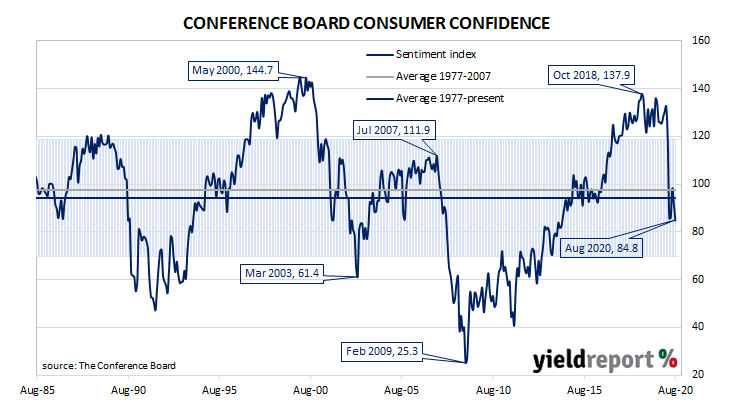Summary: US consumer confidence deteriorates for second consecutive month; view of present and future conditions worsen; consumers’ spending likely to cool; “back to pandemic lows”.
US consumer confidence collapsed in late 2007 as the US housing bubble burst and the US economy went into recession. By 2016, it had clawed its way back to neutral and then went from strength to strength until late 2018. Measures of consumer confidence then oscillated within a fairly narrow band at historically high levels until they collapsed earlier this year.
The latest Conference Board survey held during the first half of August indicated US consumer confidence has retreated for a second consecutive month after staging a modest recovery through May and June. August’s Consumer Confidence Index registered 84.8, below the median consensus figure of 93.0 and considerably lower than July’s final figure of 91.7. Consumers’ views of present conditions and of future conditions both deteriorated from those held at the time of the July survey.
“Consumer spending has rebounded in recent months but increasing concerns amongst consumers about the economic outlook and their financial well-being will likely cause spending to cool in the months ahead,” said Lynn Franco, a senior director at The Conference Board.
Longer-term US Treasury bond yields increased moderately. By the end of the day, the 10-year Treasury bond yield had gained 3bps to 0.69% and the 20-year yield had increased by 4bps to 1.40%. The 2-year yield finished unchanged at 0.15%.
In terms of US Fed policy, expectations of any change in the federal funds rate over the next 12 months retained a slight easing bias. OIS contracts for September implied an effective federal funds rate of 0.073%, about 2bps below the current spot rate.
NAB Head of FX Strategy within its FICC division Ray Attrill described the report as “on the surface, a disappointing read.” He noted the index “has tended to follow the labour market over time, offering a partial explanation. This reading puts consumer confidence back to pandemic lows.”

